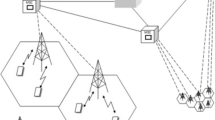Abstract
This paper proposes an efficient adaptive-rate scheme in conjunction with retransmission and code combining for transmission of ATM cells over mobile cellular networks. Wireless channel is characterized by block-fading Rayleigh distribution, where it is assumed to be invariant during each block of data and fading is assumed to be independent from one block to another. The proposed scheme provides a large dynamic range and yields very low cell-error rates at almost all channel conditions (low outage probability) with at most two retransmissions. This makes the scheme suitable for real-time applications, such as constant-bit-rate (CBR) applications intended for use in ATM circuit emulation mode [9]. Furthermore, it saves a considerable amount of power as compared to fixed rate schemes with the same spectral efficiency and outage.
Similar content being viewed by others
References
J.B. Cain, G.C. Clark Jr., and J.M. Geist, “Punctured codes of rate (n-1)/n and simplified maximum likelihood decoding,” IEEE Trans. on Information Theory, Vol. IT-25, pp. 97–100, Jan. 1979.
D. Chase, “Code combining—A maximum likelihood decoding approach for combining an arbitrary number of noisy packets,” IEEE Trans. on Comm., Vol. 33, pp. 385–393, May 1985.
D. Chase, P.D. Mullers, and J.K. Wolf, “Application of code combining to a selective repeat ARQ link,” in Proc. MILCOM'85, Vol. 1, pp. 247–252, 1985.
J. Hagenauer, “Rate compatible punctured convolutional codes (RCPC codes) and their applications,” IEEE Trans. on Comm., Vol. 36, No. 4, pp. 389–400, April 1988.
G. Kaplan, S. Shamai (Shitz), and Y. Kofman, “On the design and selection of convolutional codes for an uninterleaved, bursty Rician channel,” IEEE Trans. on Comm., Vol. 43, No. 12, pp. 2914–2921, Dec. 1995.
T. Matsumoto and A. Higashi, “Performance analysis of RS-coded M-ary FSK for frequency-hopping mobile radios,” IEEE Trans. Veh. Tech., Vol. 41, No. 3, pp. 266–270, Aug. 1992.
M. Mouly and M.B. Pautet, The GSM systems for mobile communications, published by the authors, 1992.
A. Urie, M. Streeton, and C. Mourot, “An advanced TDMA mobile access for UMTS,” IEEE Personal Commun. Mag., Vol. 2, No. 1, pp. 38–47, Feb. 1995.
H. Xie, P. Narasimhan, R. Yuan, and D. Raychaudhuri, “Data link control protocols for wireless ATM access channels,” IEEE Int. Conf. on Univ. Personal Comm., Nov. 1995, pp. 753–757.
Author information
Authors and Affiliations
Rights and permissions
About this article
Cite this article
Akhavan, K., Farahvash, S. & Kavehrad, M. An Efficient ATM Cell Transmission Scheme Over Mobile Cellular Networks. Multimedia Tools and Applications 15, 149–160 (2001). https://doi.org/10.1023/A:1011694510029
Issue Date:
DOI: https://doi.org/10.1023/A:1011694510029




